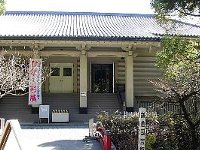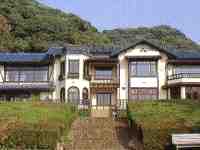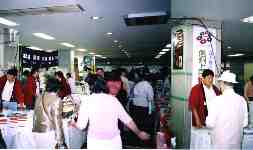Kamakura as a tourist spot in the Edo period
Tokugawa Ieyasu (徳川家康, 1542-1616) unified the country and laid the foundations for the Edo period (1603-1867). In the Kamakura area, he ordered his men to repair Hachimangu, and its repair works by other shoguns were repeated several times through the Edo period. On the other hand, he also ordered the demolition of Tamanawa Castle.Temples and shrines owned the majority of land in Kamakura at this time, although some parts of the city were governed by the Edo bakufu. To control Kamakura and its neighboring areas, the bakufu set up the office of daikan (代官), local administrator.
In the middle of the Edo period, temples and shrines were taxed so heavily that most temples and shrines were subsequently reduced to poverty, except the major shrines and temples: Hachimangu shrine, Tokeiji, Eishoji, Komyoji, Engakuji and Kenchoji Temples.
Kamakura soon became a destination for sightseeing. The city was included in a travel itinerary of the time, along with Kanazawa (金沢) in Yokohama, and Enoshima (江ノ島).
Guidebooks, and scenic pictures in the form of ukiyoe (浮世絵) woodblock prints were published, and the town was taken up in travelogues and stage dramas. Kamakura even attracted foreigners.
In 1613 and 1616 some Englishmen visited Kamakura and saw the Daibutsu.
Kamakura in the Modern era (the Meiji period)
In 1868, a new era began. The Meiji government issued the decree that Shintoism and Buddhism be separated in order to promote a policy that favored traditional Shintoism. The movement was called haibutsu kishaku (廃仏毀釈), "Abolishment of Buddhism and the discarding of Buddhist images."Buddhist structures, statues, and other related objects had to be removed from shrines, and vice versa. Many valuable treasures were lost through this movement. Tsurugaoka Hachimangu Shrine lost many Buddhist halls and other structures.
In 1889, the government instituted a municipal system. In 1894, Higashi-Kamakura-mura (East Kamakura Village) and Nishi-Kamakura-mura (West Kamakura Village) were combined into Kamakura-machi (鎌倉町) town.
In those early days, Kamakura was re-evaluated in terms of its environment. In 1880, Erwin von Balz (1849-1913), a German doctor, praised Kamakura as a health resort. And then, after Dr. Nagayo Sensai (長与専斉, 1838-1902) stated that Kamakura was ideal for sea bathing, it became widely known as a resort and seaside villa town.
The Yokosuka Line was laid out between Ofuna and Yokosuka in 1889, contributing further to Kamakura's development. Many novelists and poets who visited and wrote their works here helped to give the town a literary image and included such luminaries as Masaoka Shiki (正岡子規, 1867-1902), Shimazaki Toson (島崎藤村, 1872-1943), Natsume Soseki (夏目漱石, 1867-1916) and Kunikida Doppo (国木田独歩, 1871-1908), to name only a few.
The Enoshima Denki Tetsudo Line (江ノ島電気鉄道) opened in 1902 between Fujisawa and Katase, and in 1910 was extended through to Kamakura.
Recovery from disaster and preservation of cultural assets

|
| Kamakura Kokuhokan Museum |
In 1928, however, thanks to the efforts of the townspeople, the Kamakura Kokuhokan Treasure Hall, or Kamakura Museum, (鎌倉国宝館) was constructed to protect important cultural properties from future disasters and to display them to the public.
The Kamakura Young Men's Association (鎌倉青年会) started erecting stone monuments in 1917 to mark historic sites around town, resulting in some 77 monuments to date. In 1939, Kamakura became a city through the integration of Kamakura-machi (鎌倉町) and Koshigoe-machi(腰越町).
Present-day Kamakura
In 1948, Kamakura merged with Fukasawa-mura (深沢村) and Ofuna-machi (大船町) to become a larger city, with a population of more than 80,000.In 1958, Kamakura proclaimed the "Declaration of a City of Peace."
Soon, Kamakura had become part of the Tokyo metropolitan area, resulting in a speeding-up of residential development. This movement had a negative impact on the environment, for many of the green tracts of land disappeared.
Realizing the necessity of taking action, the Association for the Preservation of Kamakura's Scenic Beauty (鎌倉風致保存会) was organized in 1964, and some years later, the Ancient Capital Preservation Law (古都保存法) was enacted. The measures are designed to protect historic sites and prevent any land development without permission from prefectural or municipal offices.
In 1976, the city announced a fundamental plan that set out the basic principles of the administration: to build a peaceful, culture-oriented city that was blessed with a rich cultural legacy and natural scenic environment.

|
| Bungakukan |
Sports facilities--gymnasiums, swimming pools, and sports fields such as Fueda Park (笛田公園)--enjoy full use.
The Kanagawa Perfecture Museum of Modern Art (神奈川県立近代美術館, now the annex is only open) and Ofuna Botanical Garden of Kanagawa Prefecture (神奈川県フラワ─センタ─) also provide opportunities for learning and enjoyment.
Kamakura has close ties with four cities as sister cities that share characteristics in one way or another. The sister cities are as follows. The first is with Nice on the Mediterranean coast. The second, formed in 1979, is with the city of Hagi (萩市) in Yamaguchi Prefecture. Hagi is famous for traditional Hagi-yaki pottery (萩焼き). The third tie is with Ueda (上田市) in Nagano Prefecture, a city that has historical sites related to Kamakura period culture. The fourth such relationship was formed in 1982 with the city of Ashikaga (足利市), said to be the birthplace of the Ashikaga family (足利家). Kamakura and these cities promote interchanges between their citizens.

|
| Sister City Merchandising Mart |
In 1998 Kamakura established ties with Dunhuang (敦煌) in China as "Friendship City," where the large numbers of Buddhist statues and wall paintings in the caves attract visitors from all over the world.
In 2001, a new system under the name of "鎌倉市民親善都市交流, Kamakura Friendship Nextwork," aiming at promotion of friendship between cities, was introduced. This is different from "sister city" in that not city but citizens take initiative in their activities. The first tie-up was between the city of Weimar (ドイツ ワイマール市) in Germany and the city of Kamakura.